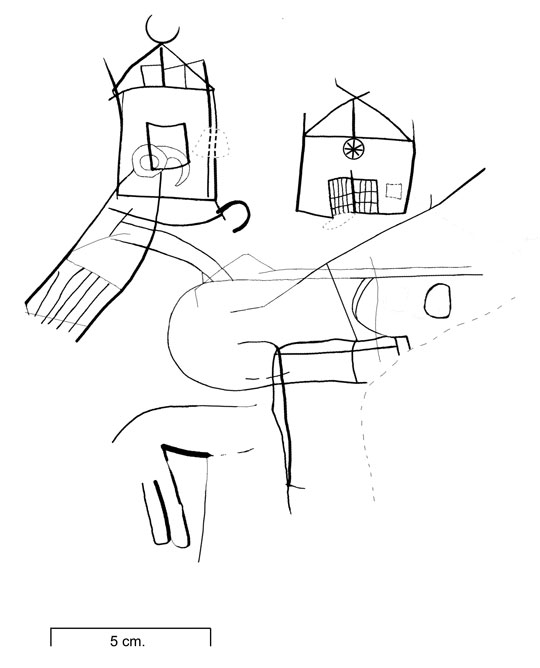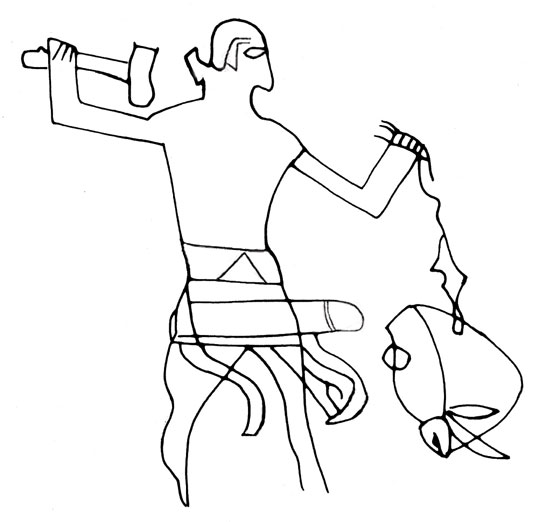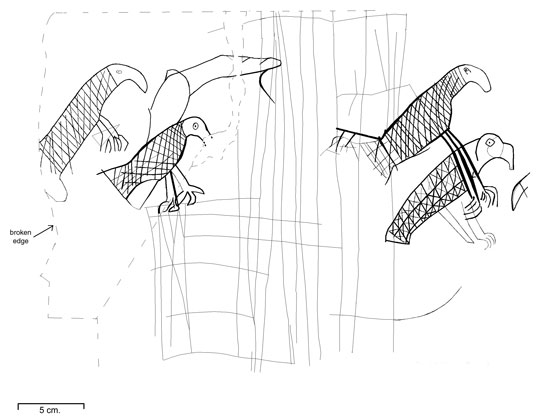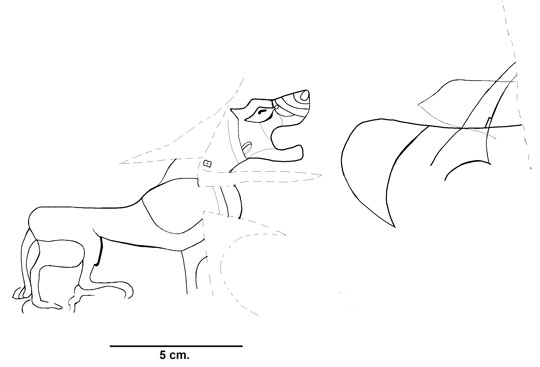The Gordion ‘Doodles’

The “doodles” are a series of drawings found on the walls of one of the buildings from the Gordion Destruction Level, Megaron 2 (Early Phrygian/YHSS 6A period). This building, located in the outer courtyard area of the citadel complex, was constructed primarily of stone and has several unusual features, including an elaborate pebble mosaic on its interior floor decorated with a series of irregular geometric patterns.

Another unusual feature is the presence of a considerable number of drawings (over a hundred) incised onto the stone blocks that form the building’s side and back walls. Most of the drawings are simple sketches whose subject matter comprises a diverse group of themes, including human figures, animals, geometric designs, and random marks that may be little more than casual scratches. There is no pattern to their position on the walls, and nothing suggests that they were an intentional form of decoration that was meant to be seen. Because of their informal character and the haphazard nature of their placement, they were nicknamed “doodles” by Rodney Young when they were first uncovered in 1956 and 1957. Young speculated that the drawings were made by visitors to the citadel complex who amused themselves while waiting outside Megaron 2 by scratching figures and symbols directly onto the walls of the building.A more careful study of these drawings indicates that this scenario is unlikely to be correct. Several of the drawings are located quite high on the building’s walls, while others are near ground level, and in neither case would this space be easily accessible to someone simply passing by. Furthermore, some of the drawings are quite deeply carved, and in a few cases almost approach the appearance of relief sculpture (Fig. 1). Incising a scene like this would require tools and a skill level that most casual visitors would not possess. Moreover, the building, one of the major structures within the walled citadel, was surely part of an official complex to which access would have been strictly limited. A more likely hypothesis is that the drawings were incised onto individual blocks before the building was constructed, and because they are located only on the side and back walls, it was not thought necessary to remove them since there was no traffic around the back of the building.
The drawings themselves exhibit considerable variety in subject matter and degree of artistic sophistication. The scenes of human figures are typical: these run the gamut from simple stick figures to complex compositions that often exhibit close parallels in style and subject matter with the formal court art found in cities in southeastern Anatolia (Fig. 2). A wide variety of animals appear, including lions, goats, horses, and several species of birds. Many drawings of lions (Fig. 3) resemble the lions that appear regularly in southeastern Anatolian relief sculpture, while several depictions of birds, especially birds of prey (Fig. 4), recall the Phrygian interest in this subject, which was the most frequent attribute of the Phrygian Mother goddess. Some drawings, such as the elevation of a Phrygian megaron building (Fig. 5), offer valuable information on the contemporary appearance of Early Phrygian Gordion, while others replicate the complex geometric patterns that occur in other media in the Early Phrygian settlement, including the patterns in the mosaic floor of Megaron 2 itself. Many others are little more than random scratches on the stone, as if someone were testing tools on the blocks. We still do not fully understand who made the drawings and why they appear on the walls of Megaron 2. Yet despite their eclectic character, the drawings are potentially very informative, since they offer insight into the contemporary interests and social and political connections of Early Phrygian Gordion.



Further reading
- Roller, L. E. 2005. “A Phrygian Sculptural Identity? Evidence from Early Phrygian Drawings in Iron Age Gordion,” in Anatolian Iron Ages 5, ed. A. Çilingiroğlu and G. Darbyshire, London, pp. 125-130.
- Roller, L. E. 1999. “Early Phrygian Drawings from Gordion and the Elements of Phrygian Artistic Style,” Anatolian Studies 49, pp. 143-151.
- Young, R. S. 1969. “Doodling at Gordion,” Archaeology 22, pp. 270-275.

